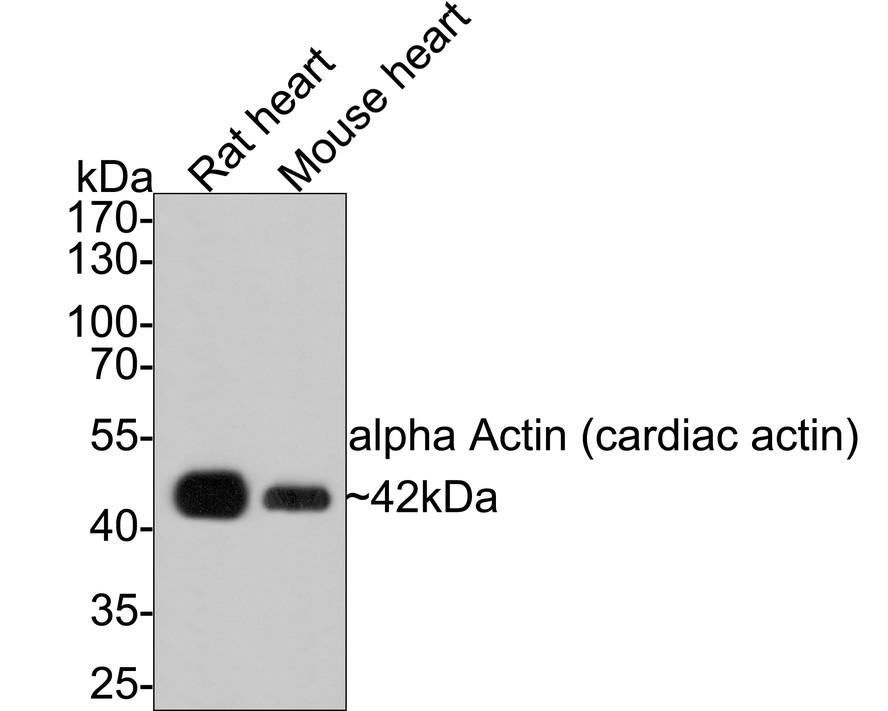alpha Actin (cardiac actin) Rabbit Polyclonal Antibody

cat.: 0407-3
| Product Type: | Rabbit polyclonal IgG, primary antibodies |
|---|---|
| Species reactivity: | Human, Mouse, Rat, Zebrafish |
| Applications: | WB, IF-Cell, IHC-P |
| Clonality: | Polyclonal |
| Form: | Liquid |
| Storage condition: | Store at +4℃ after thawing. Aliquot store at -20℃ or -80℃. Avoid repeated freeze / thaw cycles. |
| Storage buffer: | 1*PBS (pH7.4), 0.2% BSA, 40% Glycerol. Preservative: 0.05% Sodium Azide. |
| Concentration: | 1ug/ul |
| Purification: | Immunogen affinity purified. |
| Molecular weight: | Predicted band size: 42 kDa |
| Isotype: | IgG |
| Immunogen: | Synthetic peptide within Human alpha-Actin (cardiac actin) aa 1-50 / 377. |
| Positive control: | Rat heart tissue lysate, Mouse heart tissue lysate, hybrid fish (crucian-carp) heart tissue lysates, human heart tissue, mouse heart tissue, rat heart tissue. |
| Subcellular location: | Cytoplasma , etc. |
| Recommended Dilutions:
WB IHC-P |
1:500-1:1,000 1:400 |
| Uniprot #: | SwissProt: P68032 Human | P68033 Mouse Entrez Gene: 29275 Rat |
| Alternative names: | ACTC ACTC_HUMAN ACTC1 Actin alpha cardiac muscle 1 Actin alpha cardiac muscle 1 Alpha-cardiac actin ASD5 CMD1R CMH11 LVNC4 |
Images

|
Fig1:
Western blot analysis of alpha Actin (cardiac actin) on different lysates with Rabbit anti-alpha Actin (cardiac actin) antibody (0407-3) at 1/500 dilution. Lane 1: Rat heart tissue lysate Lane 2: Mouse heart tissue lysate Lysates/proteins at 20 µg/Lane. Predicted band size: 42 kDa Observed band size: 42 kDa Exposure time: 2 minutes; 10% SDS-PAGE gel. Proteins were transferred to a PVDF membrane and blocked with 5% NFDM/TBST for 1 hour at room temperature. The primary antibody (0407-3) at 1/500 dilution was used in 5% NFDM/TBST at room temperature for 2 hours. Goat Anti-Rabbit IgG - HRP Secondary Antibody (HA1001) at 1:300,000 dilution was used for 1 hour at room temperature. |

|
Fig2: Western blot analysis of Alpha-cardiac actin on hybrid fish (crucian-carp) heart tissue lysate using anti-Alpha-cardiac actin antibody at 1/500 dilution. |

|
Fig3:
Immunohistochemical analysis of paraffin-embedded human heart tissue with Rabbit anti-alpha Actin (cardiac actin) antibody (0407-3) at 1/1,000 dilution. The section was pre-treated using heat mediated antigen retrieval with Tris-EDTA buffer (pH 9.0) for 20 minutes. The tissues were blocked in 1% BSA for 20 minutes at room temperature, washed with ddH2O and PBS, and then probed with the primary antibody (0407-3) at 1/1,000 dilution for 1 hour at room temperature. The detection was performed using an HRP conjugated compact polymer system. DAB was used as the chromogen. Tissues were counterstained with hematoxylin and mounted with DPX. |

|
Fig4:
Immunohistochemical analysis of paraffin-embedded mouse heart tissue with Rabbit anti-alpha Actin (cardiac actin) antibody (0407-3) at 1/1,000 dilution. The section was pre-treated using heat mediated antigen retrieval with Tris-EDTA buffer (pH 9.0) for 20 minutes. The tissues were blocked in 1% BSA for 20 minutes at room temperature, washed with ddH2O and PBS, and then probed with the primary antibody (0407-3) at 1/1,000 dilution for 1 hour at room temperature. The detection was performed using an HRP conjugated compact polymer system. DAB was used as the chromogen. Tissues were counterstained with hematoxylin and mounted with DPX. |

|
Fig5:
Immunohistochemical analysis of paraffin-embedded rat heart tissue with Rabbit anti-alpha Actin (cardiac actin) antibody (0407-3) at 1/1,000 dilution. The section was pre-treated using heat mediated antigen retrieval with Tris-EDTA buffer (pH 9.0) for 20 minutes. The tissues were blocked in 1% BSA for 20 minutes at room temperature, washed with ddH2O and PBS, and then probed with the primary antibody (0407-3) at 1/1,000 dilution for 1 hour at room temperature. The detection was performed using an HRP conjugated compact polymer system. DAB was used as the chromogen. Tissues were counterstained with hematoxylin and mounted with DPX. |
Note: All products are “FOR RESEARCH USE ONLY AND ARE NOT INTENDED FOR DIAGNOSTIC OR THERAPEUTIC USE”.